East London Photomonth Opens
Bishopsgate Institute, London. Thur 29 Sept
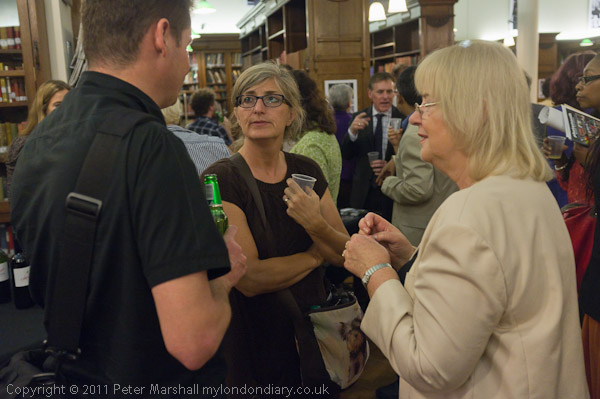
Maggie Pinhorn of Alternative Arts (right) talks to
people at the opening in the Bishopsgate Institute Library
more pictures
The East London photography festival, photomonth, is the largest photographic event in the UK, an international photographic festival with various special events as well as exhibitions in more that a hundred venues, from internationally known public galleries and museums to displays in local shops and shop windows. It is a uniquely democratic event, organised by Maggie Pinhorn and her small team at alternative arts, encouraging photographers to display their work, its nature very much a reflection of East London long a home to radical movements.
The Bishopsgate Institute where this year's opening took place is a fine example of both architecture (a listed arts & crafts / art nouveau building from 1895 by Charles Harrison Townsend) and charitable provision for the education of the then largely poor inhabitants of the area, with a fine collection of material related to the history of the area. I was particularly interested to see a wall display on Muriel Lester (1885-1968) a non-conformist social reformer and pacifist from East London, who founded Kingsley Hall in Bow where Ghandi stayed during his visit to London in 1931 and as secretary of the International Fellowship of Reconciliation toured Bihar with Ghandi during the famine of 1934.
Opposite the display on her were a set of pictures from Liverpool taken by Phil Maxwell, the earliest work in his retrospective of 40 years work mainly from the East End which continued in the library, with images on the end of book cases and high above our heads.
Despite its size and vibrancy, photomonth has never got the attention
it deserves from the UK photographic establishment or photographic press,
perhaps because the real money in the art market in photography lies in galleries
outside its area in the west of the city. photomonth is very much
an alternative rather than an establishment festival, and for me that is very
much its strength.
more pictures
Enough Is Enough - Abolish Vivisection
Embankment and Battersea Park, London. Saturday 24 Sept 2011
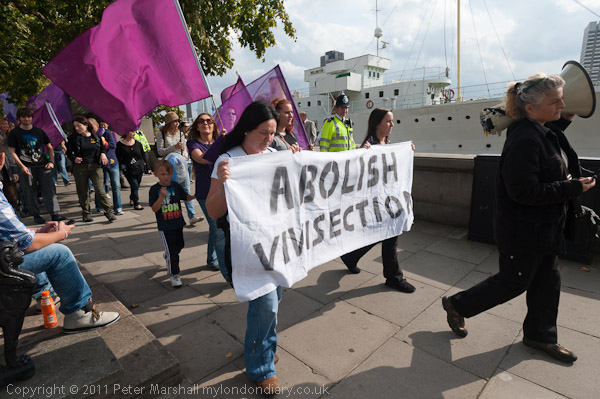
The march along the embankment
more pictures
Supporters of the National Anti-Vivisection Alliance visited the statue of the Brown Dog, commemorating the start of the campaign against vivisection in 1900, and then marched through London to take a letter to Downing St calling for an end to animal experiments.
I joined around a hundred protesters at Temple Place as after an opening speech the march was about to start. Unfortunately a number of the organisers had been unable to come at the last minute. Marching behind a simple banner with the message ABOLISH VIVISECTION, the march was a silent one, and instead of placards the marchers carried purple flags, the colour of the anti-vivisectionists. Many too wore purple clothying as a sign of their support for the cause.
The group marched up Embankment and I left them as they were on their way to deliver a letter to Downing Street and hold a protest opposite there calling for the abolition of vivisection.
Founded in 2010, the National Anti-Vivisection Alliance (NAVA) has become one of the UK's leading organisations campaigning to end animal research here. Through branches across the country they carry out peaceful demonstrations backed by investigations in a law abiding campaign "backed by scientists, doctors, lawyers, journalists and members of the public across Britain" to bring an end to the use of animals in research.
They state: "Every six seconds an animal dies in a UK laboratory - poisoned, burnt, drowned, dissected, mutilated. This does not account for those that do not make the research facilities. One in five primates die in transit, other animals are killed at breeding centres because they are not sufficient to be used in experiments."
Investigations by NAVA have already led to the closure of a number of unsuitable facilities for animals in the UK and the end to some transp-vivort of animals for research.
Public awareness of the sometimes horrific experiments being carried out on animals led to public outrage and a political controversy over vivisection in the early years of the twentieth century. The case of the Brown Dog, alleged to have been the subject of a cruel and unlawful dissection at University College led to pitched battles on the streets of London between vivisectionists, suffragettes, medical students and police in December 1907 that make our recent protests seem small beer. The scientist accused of cruelty sued for libel and following a trial in which all the details were brought to public attention won his case (and his research led to the discovery of hormones.)
A statue was erected to the Brown Dog on the Latchmere estate in Battersea, but was so controversial it had to be guarded by police 24 hours a day. Eventually the council decided to remove it - and the workers came at night with a guard of 120 police in 1910, demolishing the ornate drinking fountain for people and dogs on which it stood and taking the bronze dog to be melted down.
The current Brown Dog sculpture, hard to locate on a secluded path just to
the east of the formal English Garden in Battersea Park, was erected 75 years
later on a rather more workmanlike plinth, with four plaques telling the story
and ending - as did the 1906 statue - with the words used by today's protesters,
"Men and women of England, how long shall these things be?"
more pictures
Silent Vigil For Yemen At Downing St
Downing St, London. Saturday 24 Sept 2011
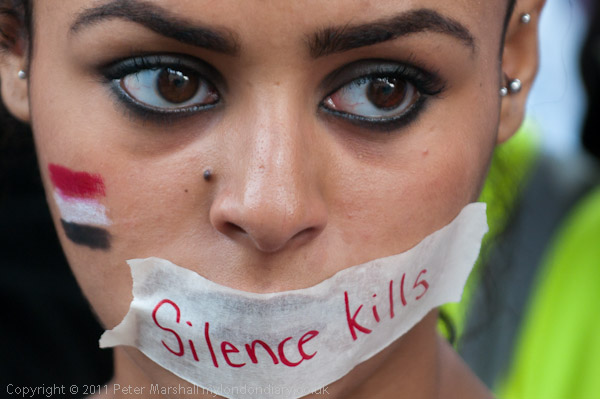
Woman with Yemen flag on her cheek and 'Silence Kills'
taped over her mouth
more pictures
Protesters from the Yemeni community held a silent protest opposite Downing St against the killings of peaceful protesters in Sanaa by troops loyal to President Ali Abdullah Saleh.
Protests against the regime of President Saleh have been taking place since January, when thousands of protesters took to the streets of the capital Sanaa and other cities in southern Yemen. T
In March, government forces opened fire on the protesters killing 52, and the president declared a state of emergency. Many politicians left the government and several of the military leaders sided with the protesters and in April the president announced he would stand down from office shortly, but then refused to sign an agreement set up by the Gulf Co-operation Council.
This led to one of the most powerful tribes in the country declaring its support of the opposition and fighting took place between the supporters of this group and the army at the start of June, and the president was injured when mortar shells fell on the presidential palace, leaving for surgery in Saudi Arabia.
Attacks on the peaceful democracy protesters who had been camping in Change Square in Sanaa and in other cities were stepped up a week ago, apparently in preparation for the president's return to Yemen which took place yesterday, Friday 23 September, with more than 50 protesters being killed in five days.
An attack today by Republican guards led by the President's son on Change Square is reported to have killed between 19 and 29 people. The army are said to have used anti-aircraft guns and rocket-propelled grenades as well as automatic weapons against the protesters and to have use Some reports put the number of protesters killed in the last 5 days as more than 100.
The protest at Downing Street was a silent one, with protesters standing
with tape over their mouths with the message 'Silence Kills' and
placards listed the number of deaths and called for freedom rather than slaughter
in the Yemen. One read "The Silence of the International Community
and Media towards Crimes against Humanity in Yemen is a Crime against Humanity".
Many held the red,white and black of the Yemen flag, and others had it painted
on their cheek.
more pictures
Intifada 11 Years Protest at M&S
Oxford St, London. Saturday 24 Sept 2011
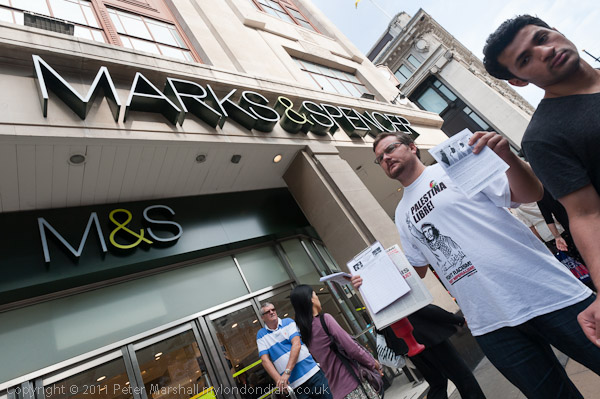
Handing out leaflets and collecting petition signatures outside Mars &
Spencer on Oxford St
more pictures
The Second Intifada or 'Al-Aqsa Intifada' started shortly after the failure of the Camp David Middle East Peace Summit between US President Bill Clinton, Israeli Prime Minister Ehud Barak and the Chairman of the Palestinian Authority, Yasser Arafat in July 2000.
One of the several major issues on which the participants could find no agreement was Jerusalem and the Temple Mount, and although Yasser Arafat was allegedly planning the Intifada prior to September 29th 2000, possibly in connection with the unilateral declaration of a Palestinian state that he had abandoned a couple of weeks earlier, it was undoubtedly the visit to the Temple Mount, also the site of the Al-Aqsa mosque, by Likud party candidate for Israeli Prime Minister Ariel Sharon that acted as the trigger for riots and clashes between Palestinians and Israeli police and security forces. In the next five days, 5 Israelis and 47 Palestinians were killed and 1885 Palestinians wounded.
In 2005, Mahmoud Abbas was elected president of the Palestinian Authority, having run on a policy of peaceful negotiation and non-violence against Israel. The day before he was inaugurated, Ariel Sharon, now president of Israel, froze all contacts with Abbas, but a month later following international pressure the two men declared a truce at Sharm el-Sheik, often seen as the end of the Second Intifada.
The day following Mahmoud Abbas's request to the UN to recognise a Palestinian state, a special demonstration outside the Oxford Street Marks & Spencer (M&S) marked the 11th anniversary of the Al-Aqsa Intifada.
There has been a regular weekly picket of this branch of M&S every Thursday evening for over ten years, starting shortly after the start of the Second Intifada in 2000, as well as pickets on Saturday lunchtimes.
When I arrived as the event was starting there were around a dozen activists handing out leaflets, talking with people passing by, collecting signatures for a petition and running a literature stall. Banners, posters and leaflets made clear why they were demonstrating and calling for people to boycott M&S.
They state that M&S has the strongest and most long-stading support for Zionism of any British retail company, supporting Israel with £240 million of trade each year. They sell goods from illegal settlement exporters including Carmel Agrexco and Hadiklaim and are major outlets for socks, underwear and lingerie made by the major Israeli textile compy Delta Galil and Israeli suit manufacturer Bagir.
M&S give financial support to various Zionist social projects including World Ort, which supported Israel's war crimes in Gaza, and have recieved awards from Israel for their support.
The Palestinian Authority want the recognition of a Palestinian state based
on the 1967 borders, as demanded by Security Council resolution 242, made
following the Six Day War. Over 120 of the 193 countries currently in the
UN already recognise Palestine.
more pictures
Apprentice Boys Carson Memorial Parade
Temple, London. Saturday 17 Sept 2011
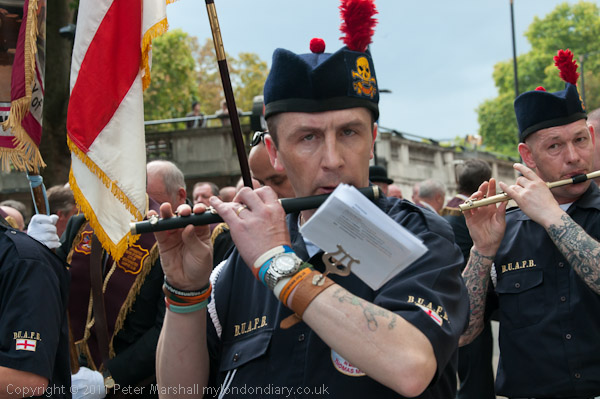
The British Ulster Alliance Flute Band
more pictures
The City of London Campsie Club, a branch of the Apprentice Boys of Derry, held their annual Carson Memorial parade on Saturday, marching to lay wreaths at the Cenotaph.
The Campsie Club gets its name from Henry Campsie, leader of the 13 apprentice boys who took the keys an shut the Ferryquay Gate of Londonderry against King James II and his army in 1688. He was severely wounded when they went on to take over the city's magazine and arms store.
Lord Carson became a member of the Orange Order at the age of 19, and was a leading judge and politician in the UK around the start of the 20th century, becoming Solicitor General. In 1911 he became the leader of the Ulster Unionists, determined to fight against home rule for Ireland by "all means which may be found necessary", and was one of the founders of a unionist militia that became the Ulster Volunteer Force.
When Ulster opted out of Home Rule, Carson resigned as unionist leader and came back to London to work as a judge feeling he had few connections in Ulster and did not want to serve as Prime Minister in the Northern Ireland parliament. Although an Orangeman he warned Unionists not to alienate Catholics in the north: "from the outset let them see that the Catholic minority have nothing to fear from a Protestant majority."
Parades in Northern Ireland have unfortunately had the opposite effect over the years, but in London they are more simply a celebration of cultural and religious identity. I've photographed this and other Orange parades over the years, and many on them have seen my work on the web and appreciated it - and sometimes used my pictures.
But a few of the nastier elements of Northern Ireland remain, and in 2008 and again while photographing this year's parade I was threatened and pushed away by some of those taking part. It's a thuggishness that has no place on English streets, and something that the Orange Order should take firm action against. I fully support religious freedom and the freedom to demonstrate on our streets, but there is no place for this kind of conduct. It sullys the memory of one of our great British (and Irish) jurists, and is an insult to the Protestant faith into which I was born and in which I grew up.
The parade seemed to be rather smaller than in some previous years with fewer visiting groups taking part. Among those marching with the City of London Campsie Club were the Westminster Campsie Club, the London Somme Association, their banner commemorating the actions of the 36th Ulster Division in the First World War, The British Ulster Alliance, Corby Loyalists and the Rising Sons of William Flute Band from Cormeen in Northern Ireland.
I left the marchers as the made their way from Temple along the Embankment
towards the Cenotaph where they were to lay wreaths, before going back to
Temple.
more pictures
London Oddments
London. Saturday 17 Sept 2011
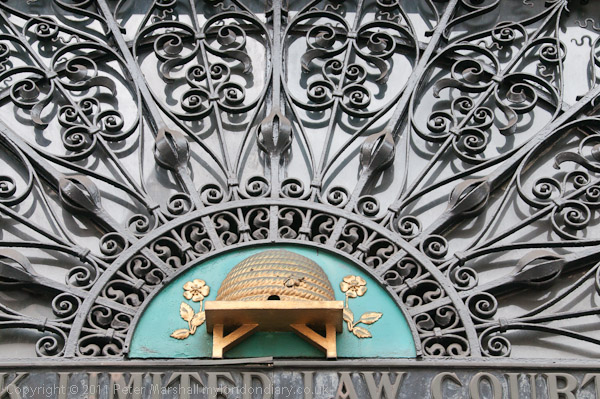
The beehive a symbol of thrift and industry
more pictures
I started off at Bank, where I had hoped to see something a little more interesting than a picnic taking place. There were long queues along in front of the Bank of England, but not of anxious investors eager to get their money back, or exchange those Bank of England paper notes with their signed promise to pay the bearer on demand for some more real currency, but simply people wanting to get a look around the interior on 'Open House' day. I've been in once and didn't bother to join the queue.
I made my way down Fleet St towards the Strand, stopping to take a few pictures - Gog and Magog, guardian giants of London, helped by a dragon in the middle of the road, the offices of the Dundee Courier, People's Friend, People's Journal and Sunday Post, the Royal Courts of Justice, a fat monk with a cat and a beehive...
I've also been in the Roman Bath House in Strand Lane - probably a Tudor construction - but since there wasn't a queue and I had a few minutes to fill I went in again to take another look.
Later, as I strolled across Waterloo Bridge, the Thames was full of small
boats being rowed or paddled up with the tide from North Greenwich to Ham
in the 'Great River Race', two of which had a minor collision as they came
up to the bridge.
more pictures
March For A Secular Europe
Temple, London. Saturday 17 Sept 2011
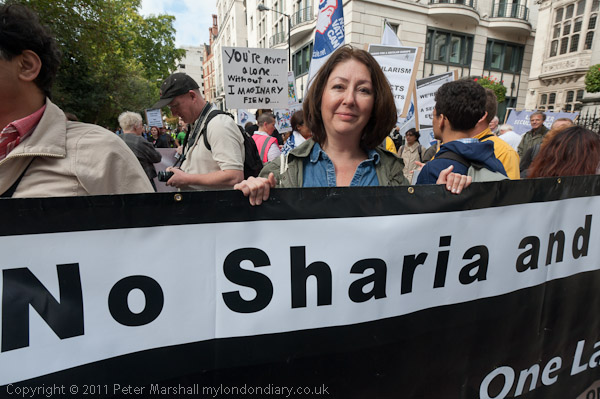
Maryam Namazie holding the 'One Law For All' banner
more pictures
The Secular Europe Campaign held a march and rally in London, calling for an end to religious privileges and for European institutions to remain secular. London, UK. 17/09/2011.
The campaign was started in 2008, and has a particular focus on the Vatican because of the enormous power and influence it has. As well as the London march, a similar protest was taking place today in Rome, protesting about the huge three billion Euro tax exemption the Vatican enjoys.
A year ago, the campaign led the protests against the Pope's visit to the UK, with several marches, including one while the Pope was here attended by more than five thousand people. today's event was less than a fifth of that size but was still considerably larger than earlier marches by the campaign I've attended. The organisers were hoping for a larger march, but in the absence of any strong single current issue this seemed a decent size.
Many of the placards reflected the focus on the Catholic Church and the Pope, though more were concerned with the church's covering up of sexual offences by clergy than tax avoidance.
But the campaign is much wider than that, and "aims at representing all the issues around secularism and human rights, including opposition to state-funded faith schools, rejection of religious tribunals and support to equal rights for LGBT citizens."
Many of those attended die appear to be somewhat militantly atheist, which perhaps limits its appeal. There are after all many moderate Christians (and probably those from other religions) who would wholeheartedly support its stated aims.
Among those on the march was 'One Law For All', opposed to all religious
laws and in particular to any attempt to impose Sharia law in the UK. It was
also supported by humanist and gay rights groups including the British Humanist
Association, the Central London Humanist Group, the Gay And Lesbian Humanist
Association, the National Secular Society, OutRage! and the Rationalist Association.
There were also several groups from Europe, including France and Italy.
more pictures
Wreath For Victims At London Arms Fair
Royal Victoria Dock, London. Friday 16 Sept 2011
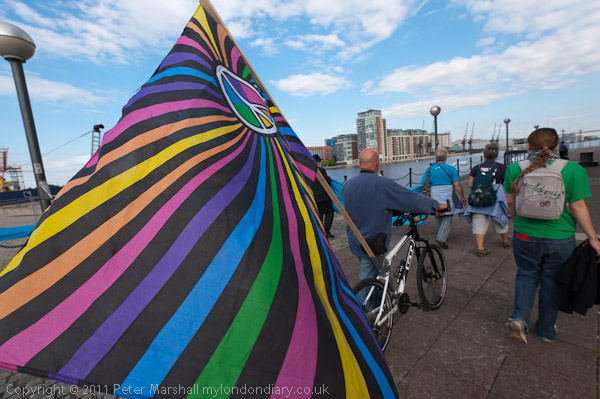
The campaigners walk along the opposite side of the
dock to the Excel Centre
more pictures
On the last day of the DSEi Arms Fair in London Docklands, East London Against Arms Fairs processed around Royal Victoria Dock and floated a wreath for victims of the arms trade in the dock opposite the fair.
The funereal procession made its way slowly around the dock side, led by woman carrying a wreath followed the East London Against Arms Fairs (ELAAF) banner and small group with other banners and flags, with the rear being brought up by six policemen.
ELAAF organises regular protests against holding the Arms Fair here and has received considerable support from local residents and councils. The arms fair is unpopular in the area not just becuase it sells arms to repressive regimes around the world, but also because of the considerable disruption to local life it causes, with a large area around the ExCel Centre being closed to the public, the closure of roads and footpaths, including the high-level bridge across the dock to West Silvertown, and disruption to local stations on the DLR.
Because of the closure of large areas it is impossible to protest around the arms fair itself, although at other times of the year campaigners protest against it outside the ExCel centre. However it is still possible to walk along the opposite side of the very wide dock, and the procession slowly made its way along the dockside to some steps opposite the centre.
As they did so, several small military boats demonstrated their paces on the dock, throwing up a considerable wake, and crowds on the terrace outside the Excel centre watched them, with the small procession singing peace songs visible in the background, though the songs were most of the time surely drowned out by the engine roar, as well as the frequent planes coming over us to land at London City Airport.
When we reached the steps close to the closed high-level bridge which leads across to the centre the procession halted and after a few short words the wreath, with its dedication "Remember victims of the arms trade" was placed in the water and floated away. The group then observed a two minute silence, and perhaps by coincidence the boats had also stopped for that time, starting up again later as the protesters walked on after singing two more peace songs.
There was a further short vigil at the end of the path opposite the centre
where the protest ended.
more pictures
Flash Mob Against Dale Farm Evictions
Bressenden Place, London. Thursday 15 Sept 2011

Singing at the protest
more pictures
A flash-mob protest at the Department of Communities and Local Government called for the eviction of travellers from the Dale Farm site they own to be abandoned, and for councils not to evict where a family member had been involved in the riots.
The flash mob appeared on the dot of 5pm, but was rather smaller than anticipated, almost outnumbered by the photographers and journalists. Eventually there were around 30 people, most of whom sat on a few sheets of newspaper and cardboard in front of Eland House, the home of the Ministry of Communities and Local Government.
Although most of the protesters were from the left, socialists or anarchists, one well-known Muslim member of the English Defence League came up at the start to ask me and the other press what was happening and stopped to take part in the protest.
Many of the activists who might otherwise have come to the protest are already at Dale Farm in Camp Constant there, set up to oppose the bailiffs who are expected to come and evict them on September 19th. Yesterday there were rumours that the eviction was about to start earlier than the date previously leaked from Basildon Council, but nothing has yet happened. Many expect the bailiffs simply to deliver notice to the residents on the 19th when the activists will be ready for them and large numbers of press are expected to attend, and to return a few days later in the middle of the night to dismantle the defences and remove the activists before starting on evicting the protesters.
There is increasing international pressure on the government to stop the evictions and put pressure on Basildon Council to come up with a culturally acceptable solution. Although the courts, council and government insist that it is simply a planning issue, most from outside the UK (and many inside) who have examined the issue see it as the culmination of essentially racist manipulation of planning procedures by the Basildon over many years. Almost all other councils have also failed to make adequate provision for travellers, and the rather limited requirement that they should do so was largely removed by parliament some years ago.
The protesters came with a single tent and banners with the messages 'Homes Not Jails' and 'Housing is a Human Right'. A smaller poster, written in biro on the back of a cardboard box summed up the mood of the protesters: 'Housing Justice for ALL! Save Dale Farm - evict the tories!', and one of the speakers held up a banner with the words 'Eviction Notice - 6 Months Warning', calling for radical changes in Con/Lib Dem coalition policies or else the people would get rid of them.
A couple of people came up separately during the protest to argue with the protesters. The first argued that they were being evicted on planning grounds, but the second said that they should all go home to Ireland, and was surrounded by a group of protesters calling him a racist. Again he left after a minute or so, and here were no threats of violence.
There were quite a few police standing some way back and watching the protest,
and the front of the Ministry where the protest was taking place had been
closed before it started.
more pictures
Arms Fair Fracas At National Gallery
Trafalgar Square, London. Tues 13 Sept 2011
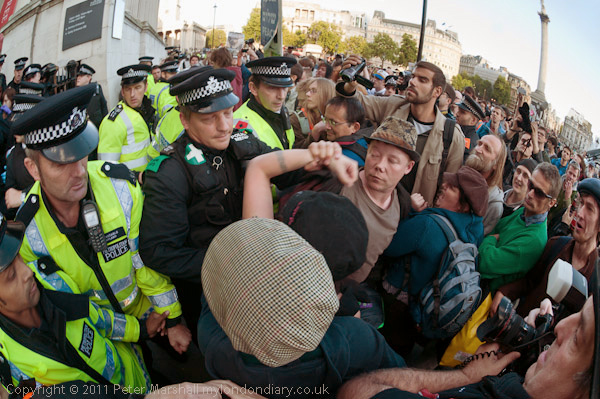
Police force protesters away from the steps of the gallery
more pictures
After a day of peaceful demonstrations against the DSEi Arms Fair in London, a fracas developed as police attempted to clear the National Gallery steps while peaceful protest continued below in Trafalgar Square. London, UK. 13/09/2011
A group of well over a hundred protesters came to the National Gallery as it was closing to protest at a dinner being given there for those attending the DSEi arms fair, including representatives of many of the most repressive regimes around the world. The protesters attempted to enter the Gallery as it was closing but were ushered out by security staff, and then began a peaceful protest on the steps of the gallery.
The protest came at the end of a coordinated day of action on the opening day against DSEi (Defence & Security Equipment International), the world's largest arms fair, which takes place every two years at the ExCel centre in London Dockland by the 'Stop the Arms Fair Coalition' .
Gallery staff asked protesters to leave the steps but some decided to stay and display banners there, while others continued to protest peacefully on the North Terrace in front of the gallery, displaying banners and holding a 'die-in.'
After a while police came and asked the protesters to move, and with a great deal of argument and protestation they were moving very slowly down the stairs. There was quite a lot of joking between some of the police and protesters and the atmosphere was generally friendly, although the protesters were not being cooperative.
Suddenly one of the protesters was roughly carried away by police towards a nearby van. He did not appear to be formally arrested, and police would give no reason for his detention either to press. legal observers or protesters.
The incident, and in particular the lack of communication, changed the mood of the event and tempers on both sides rose somewhat. When police in larger numbers arrived and finally cleared the steps as protesters linked arms to prevent their removal, well in the main they used the minimal neccessary force, there were a few incidents of what seemed thuggish violence towards both men and women, and several more were dragged away towards the police vans. It is never possible to see everything that happens in such confused situations, but their offence seemed to have been arguing and trying to protect themselves against police violence. For a few moments things did seem to get a little out of hand and one senior officer pushed violently past me and entered the affray with what looked like gay abandon. Apart from these exceptions the police had generally behaved well over the day, doing a difficult job with proper respect for the right to demonstrate as well as for the safety of the public.
Meanwhile on the pavement in front of the gallery the peaceful demonstration
by the 'Stop the Arms Fair Coalition' continued, with a large number of people
taking part in a 'die-in'. A speaker from 'East London Against Arms Fairs'
made a speech explaining to the crowd that had gathered why the protest was
taking place and calling for an end to UK arms sales to authoritarian regimes
(including Kuwait and Saudi Arabia, both responsible for the ruthless suppression
of people in the 'Arab Spring' as well as countries involved in major armed
conflicts and human rights abuses.
more pictures
DSEi Protest at BAE Systems
Carlton House Terrace, London. Tues 13 Sept 2011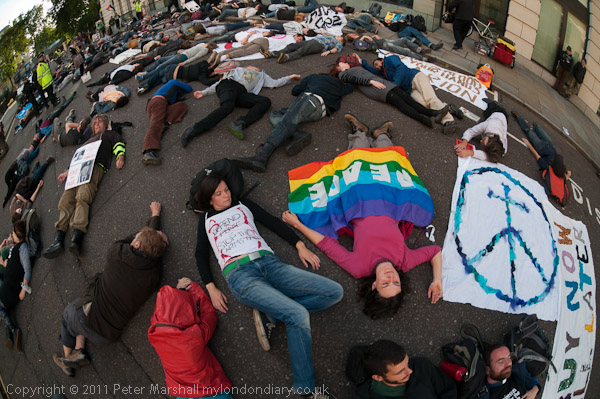
The mass 'die-in' on the road outside the BAE offices
more pictures
Protesters against the DSEi arms fair staged a die-in outside the London offices of BAE Systems, a major arms company that has been alleged to be involved in corrupt deals in many countries.
The Serious Fraud Office was forced to drop its enquiries into bribery over an arms deal by BAE Systems with Saudi Arabia by then UK government afer a Saudi royal prince threatened cancellation of the order in 2006. The Campaign Against Arms Trade (CAAT) obtained a High Court decision that this breached the OECD Anti-Bribery Convention, but the government appealed and the law lords decided that national security should be an overriding principle and overturned the decision.
The lords got BAE off the hook, although the government decision was seen by most as an admission of BAE's guilt in the matter. According to The Guardian they have also been under investigation for bribery in Chile, Romania, South Africa, Tanzania, the Czech Republic and Qatar.
BAE systems are one of the world's largest arms companies, producing fighter aircraft, warships, missiles and tanks along with other weapons. They are also one of the companies that will profit hugely from the replacement of Trident nuclear missiles, a high-spending and potentially dangerous project with no military significance.
The protest outside their offices in Carlton House Terrace, close to Buckingham Palace and easy lobbying distance from Whitehall was part of a coordinated day of action by the 'Stop the Arms Fair Coalition' against DSEi (Defence & Security Equipment International), the world's largest arms fair, which takes place every two years at the ExCel centre in London Docklands, and took place on its opening day. The coalition includes the Campaign Against the Arms Trade (CAAT), Disarm DSEi, East London Against Arms Fairs, Fellowship of Reconciliation, London Catholic Worker, Pax Christi, Stop the War Coalition, Trident Ploughshares, War or Want and other groups.
There were a few songs and some very short speeches before almost all of
those present, except for a few who kept holding banners in the doorway of
BAE, got down flat on the pavement for a die-in. After around five minutes
on the ground, filling a 50 yard or so stretch of the road, everyone got up
and left. This protest was listed as the last in the day of action, but most
of those present were going on to take action at the National Gallery, which
was hosting a dinner for those attending the DSEi arms fair.
more pictures
Down the Drones City Arms Fair Protest
Tower 42, Old Broad St, City of London. Tues 13 Sept 2011
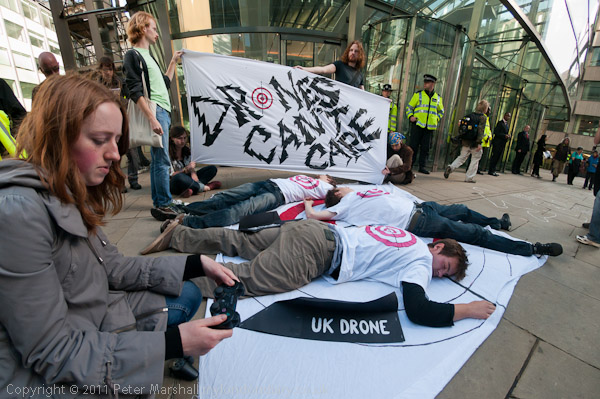
Protesters briefly laid on a large target on the pavement
while another held a games controller
more pictures
FoR and Speak organised a protest against drones - remote-control killer robots - outside the new London offices of General Atomics makers of Predator and Reaper drones.
This action was a part of the Day of Action by the 'Stop the Arms Fair Coalition' against DSEi (Defence & Security Equipment International) on its opening day. DSEi is the world's largest arms fair, and takes place every two years at the ExCel centre in London Docklands The coalition includes the Campaign Against the Arms Trade (CAAT), Disarm DSEi, East London Against Arms Fairs, Fellowship of Reconciliation, London Catholic Worker, Pax Christi, Stop the War Coalition, Trident Ploughshares, War or Want and other groups.
This legal non-violent protest at the Tower 42 offices of General Atomics was organised by the Fellowship of Reconciliation (FoR) and Speak Network, which connects "together young adults and students to campaign and pray about issues of global injustice." FoR is an interfaith movement, founded in 1914 and with permanent representation at the UN and describes itself as "an international, spiritually-based movement of people who, from the basis of a belief in the power of love and truth to create justice and restore community, commit themselves to active nonviolence as a way of life and as a means of personal, social, economic and political transformation."
Around 50 people turned up outside the offices at Tower 42 in Old Broad St, at one time the tallest building in the city but now long eclipesed. They chalked slogans on the pavement, displayed banners, sang and handed out leaflets to passers by about the dangers of militarism.
The had intended to to invite passing members of the public to use a Playstation controller to play 'Remote Control Killer Robots' so they could discover "how targeted and preice armed drones really are." Unfortunately although there is a lot of empty space open to the public around the tower, only a narrow strip of the pavement is public space, and with the police insisting on keeping a passage clear this game proved impossible.
Using drones turns warfare for those 'piloting' them from a centre perhaps several thousands of miles from the battlefield into something very much like a computer game, removing any normal human inhibitions about the indiscriminate killing of others.
The US is currently using around 48 Predator and Reaper drones in Iraq and Afghanistan, controlled from an airforce base in Nevada. One of their main advantages is that they can remain in flight for long periods of time - up to 42 hours - while waiting for the order to strike. The UK has around 10 active MQ-9 Reapers in Afghanistan, operated by RAF pilots also at the Nevada base.
Shortly before the protesters left Tower 42 the police allowed the protesters
to briefly lay their target cloth out on the pavement and pose for photographs
for a few seconds.
more pictures
Secret Gardens of St John's Wood
Queens's Terrace Café, St John's Wood, London. Tue 13 Sept 2011
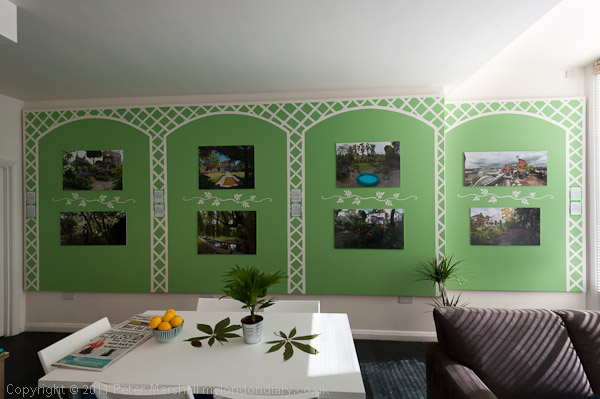
The main wall of the café with 30" or 36"
wide prints. Design & decoration by Jiro Osuga.
more pictures
During a gap between protests I rushed to St John's Wood and the Queens's
Terrace Café, where my show 'Secret Gardens of St John's Wood' had
been hung at the weekend, and I had been too busy to be there. I took a series
of location views of the show before rushing back into the city of the next
protest.
more pictures
Dr Zig's 'Bubbles Not Bombs' Protest
Thames Embankment, Tate Modern, London. Tues 13 Sept 2011
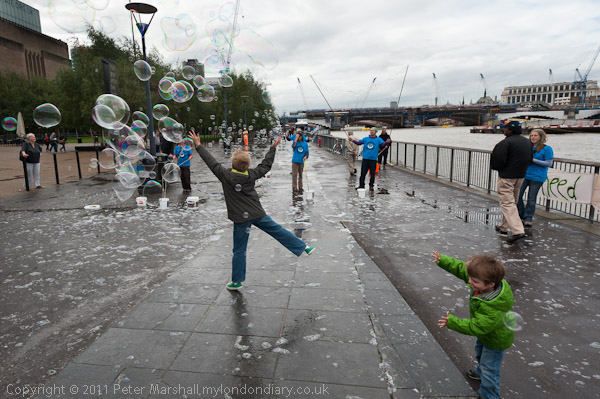
Kids try to catch the bubbles from the peace protesters
more pictures
Dr Zig and his gang came from Wales and made their "seriously HUGE bubbles" on the riverside walk outside Tate Modern, shouting "Bubbles not Bombs" as a child-friendly protest against the DSEi Arms Fair.
This protest was part of a coordinated day of action by the 'Stop the Arms Fair Coalition' against DSEi (Defence & Security Equipment International), the world's largest arms fair, on the day that it opened in London Docklands. In child-friendly terms it is a place "where bad people the world over can come and buy the latest in guns, drones, warships etc."
The Dragon Bubbles were indeed impressive, although the weather was perhaps not at its best for them, with a strong gusty wind and occasional showers, and there were fewer walkers along the path than usual. Between the showers, the performance did gather some small crowds, and a few children (and some not so young) were at times delightedly chasing and trying to catch the bubbles.
Along the railings by the river, a large banner spelt out the message 'Kids need human rights NOT cluster bombs' while another larger banner in colourful lettering on the other side of the path simply stated 'Stop the arms fair.'
Dr Zig and his gang were hoping to go on to the ExCel Centre where the DSEi
was taking place to "bubble mob" the arms dealers later
in the afternoon.
more pictures
Arms Fair Protest At Parliament
Old Palace Yard, Westminster, London. Tues 13 Sept 2011
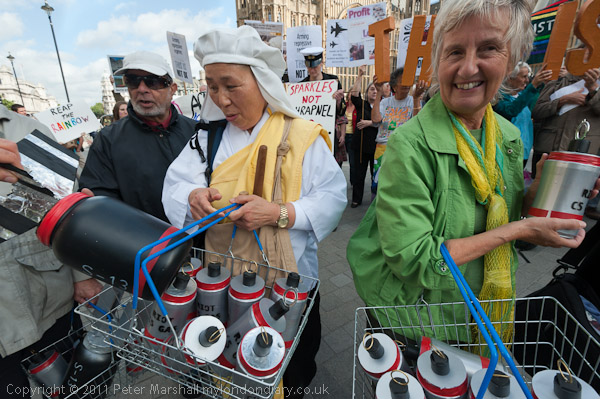
A queue with loaded baskets waits to pay at the arms
fair supermarket
more pictures
Around 250 protested opposite parliament against the government sponsored DSEi arms fair at the Excel Centre in East London where arms are being sold to repressive regimes.
The protest began with singing from socialist choir 'Raised Voices' and then there was a mock 'Arms Supermarket' where people, including veteran peace campaigner Bruce Kent and a Buddhist monk, queued at the till to pay for their purchases in fornt of people carrying placards agains the arms fair and letters spelling out the message 'THIS IS NOT OK'.
The rally continued with a number of short speeches, inclduing a powerful performance by our only Green MP, Caroline Lucas, who urged us all to press our MPs to sign the early day motion against the arms fair she has proposed.
She said it was hardly surpsing that the government had kept quiet about those attending to the last minute, as the list contained many unsavoury countries, including Bahrain and Saudi Arabia whose troops had gone to supress popular feeling in Babhrain.
The protest was organised by the Campaign Against Arms Trade (CAAT) as a part of a week of action against the DSEi arms fair and supported by other groups, including various peace and anit-war groups. Among them were " 'Sparkles Not Shrapnel' and their gorgeous allies", a LGBT Queer action against the DSEi arms fair and the international arms trade in what they called " 'Operation Hello Sailor' (Code Word: Ahoy!)"
It was a serious and purposeful event, but also one which set out to inform and and also to entertain the public. Few people other than the protesters appeared to be aware that there was an arms fair taking place in London, and were surprised to learn that the UK is one of the major arms suppliers to trouble spots around the world.
Although the UK has a policy which claims to include safeguards to make sure that arms are used for "legitimate purposes, not for internal repression" this is a simple fictional figleaf and their actions tell a different story. Both this and the previous Labour government have sold weapons to countries that have used them to repress their own people, and it was hardly a surpise that David Cameron's first action on hearing about the 'Arab Spring' was to rush out to the region with a group of arms salesmen.
Many of the weapons used by Gadaffi's regime over its years of repression and its fight against the revolution came from the UK. In 2010 the UK government issued licences for the export of £218 million of miltary equipment there, including tear gas and sniper rifles.
The UK Government's Human Rights Annual Report for 2010 listed 26 countries where there was considerable concern over human rights violations, and in the same year it approved arms exports to 16 of these,including as well as Libya, Israel and Saudi Arabia.
Although our government stated that the Sri Lankan offensive against the
Tamil Tigers "raised grave concerns over human rights",
they took place with the help of weapons supplied by the UK and we continue
to supply them to Sri Lanka. The government has also admitted that UK weapons
were almost certainly used by the Israeli armed forces in their 2008-9 attack
on Gaza, 'Operation Cast Lead' in which around a thousand civilians,
including 350 children, were killed.
more pictures
9/11 Anniversary - EDL & MAC
Grosvenor Square, London. Sunday 11 Sept 2011
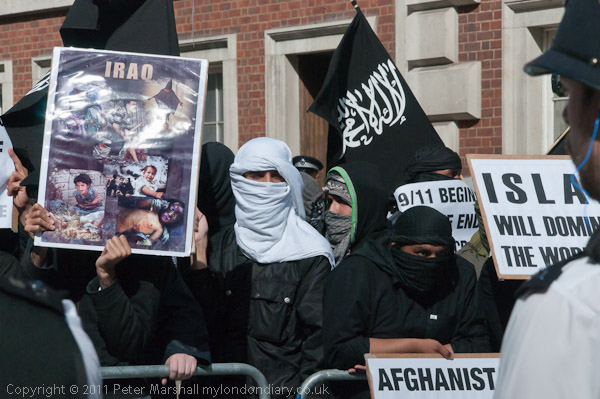
Muslims Against Crusades were held in pen just to
the north of the square and the EDL just to the south
more pictures
Muslims Against Crusades came to Grosvenor Square to protest noisily near the US embassy throughout the afternoon during the 10th anniversary of 9/11. The EDL and others turned up to show their disgust at the MAC.
Today was the 10th anniversary of the attacks on America that are universally known as 9/11, and an official event was held at the memorial in Grosvenor Square to commemorate this, including a minute's silence for the three thousand who died as a result of these attacks.
Anjem Choudary's extremist group, Muslims Against Crusades had earlier posted an animation involving aircraft crashing into towers on their web site and announced their intention to hold a noisy protest at Grosvenor Square to break the silence and to make clear their opinions to those attending the Grosvenor Square event.
Security in Grosvenor Square was heavy and the police had decided to provide two pens just outside the square on opposite sides; on the north side for MAC, and on the south for the EDL who had announced their intention to demonstrate against MAC's attempt to disrupt the commemoration.
First to arrive were the EDL, and a group of around 50, some carrying wreaths and flowers, came to a pen set up by police close to where the MAC were to protest. Police objected to their presence there, and after some heated discussion an officer read out a 'Section 14' notice under the Public Order Act 1986, which allows police to specify the location of a protest (and numbers and duration) when reasonably necessary to prevent serious public disorder.
The EDL argued that they were behaving peacefully and with suitable respect for the occasion and wished to lay the wreaths and flowers which some were carrying and so there was no threat of serious public disorder, but it would have been difficult to sustain that argument given their behaviour at some previous events. Eventually the police persuaded them to move and escorted them across in front of the heavily guarded US Embassy to a pen on a side road off the opposite side of the square. Like a number of other individuals who arrive during the afternoon they were not allowed to lay wreaths at the memorial, but police did take one of their wreaths and say it would be laid later. Others were told they could come back after 5pm to lay wreaths.
Once the EDL had been moved, police allowed the MAC to enter their pen, which was a few yards back from the square on a side road. There was a double row of barriers between them and the square, but despite this, police almost immediately moved photographers further back, and put two widely spaced rows of police in front of the protesters, moving the photographers behind these. They made sure it was not possible to properly photograph the MAC from inside Grosvenor Square.
There were the usual speeches from Anjem Choudary and a couple of other leading members of MAC, as well as from a visitor from the Lebanon. They argue that the number who died on 9/11 is small compared to those killed by the US in Iraq and Afghanistan, and their overall message, repeated in their posters, was that Islam is the fastest growing religion and will take over the whole world.
They came with powerful loudspeakers, and their message bounced off the large frontage of the US Embassy and resounded around the whole square, and must have been very noticeable to those taking part in the commemoration at the far end of the gardens (which was being covered under the normal 'pool' arrangements for such major events with other photographers being excluded.)
The EDL had been sidelined (and most soon disappeared) but the MAC managed to protest as they had intended. There were rumours that they had again burnt a US flag as a part of their protest, but I could not see this from where the press were allowed to photograph.
The policing prevented any serious clash between the MAC and the EDL while
I was present, but also kept both groups just outside the square in which
they wanted to protest. And although relations between police and press were
generally good, a number of photographers with press cards were refused access
to the square and some of the restrictions imposed seemed unnecessarily restrictive.
more pictures
March Supports Dale Farm Against Evictions
Wickford to Cray's Hill, Essex, UK. Saturday 10 September 2011
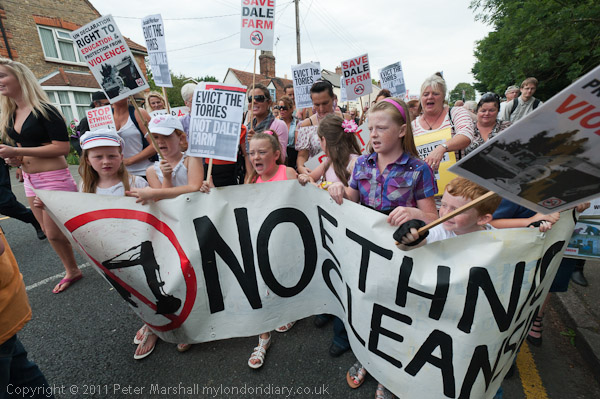
Children lead the march after a short stop for prayers
in the centre of Wickford
more pictures
Over 200 people, including some women and children from the travellers site at Dale Farm marched over 3 miles from Wickford Station to a rally at the site in a protest against the planned eviction there.
The marchers stopped in the centre of Wickford for a bible reading and brief prayers before continuing on the march, with children at the front initially holding the main banner, then skipping along in front of it and playing to the cameras. Three young women, with a banner 'No Ethnic Cleansing at Dale Farm' spent most of the march joking with policemen, posing for photographers and singing loudly and tunefully.
Children, some of whom had carried a placard 'We Love Our School' ran ahead to pose in front of it when we reached Cray's Hill, and they were joined by Labour Euro-MP Richard Howitt who had marched the whole way and spoke at the rally afterwards.
Despite the desperate situation the travellers face it was a very cheerful and optimistic event and there was never the slightest hint of any violence. The only slight unpleasantness came when we reached Camp Constant, where many volunteers who have come to oppose the eviction at Dale Farm are living - its name comes from the firm of bailiffs, Constant and Co, which was awarded the multimillion-pound contract to carry out the Dale Farm evictions.
One of the march organisers, a non-traveller who had been filming the event (and had already annoyed the press on several occasions by deliberately walking in front of those photographing or filming) tried to get the travellers to refuse the press access to the site and the protest camp, although many of us had earlier been invited to visit their homes by the travellers on the march.
We were stopped and kept waiting for around ten minutes until one of the women leading the travellers insisted we be allowed inside, and we were then able to photograph the rally there. It seemed ridiculous and entirely counter-productive to deliberately try and antagonise the journalists and photographers, most of whom are sympathetic to the cause of the Dale Farm residents - even if the editors of some newspapers clearly are not.
Basildon Council have for a long time been trying to get rid of the travellers who have made their homes on land that they own at Dale Farm, a little over three miles from Wickford and a similar distance north of Basildon.
The land had been concreted over in the 1950s and was in use as a registered scrap yard and was contaminated by toxic waste. The travellers bought the land on the advice of the Local Planning Authority, but unfortunately only half the land was granted planning permission for the site.
Although situated within the green belt, this has not been true green belt for more than 50 years, and the council's decision to pursue the matter through the courts to the bitter end of evicting the community can only be understood in terms of racism. Basildon is not alone in this; the Commission for Racial Equality reports that 90% of all Traveller planning applications are initially refused compared to the normal rate of 20%.
The eviction is expected to cost the council around £18 million, and is totally unnecessary, even to meet the two reasons the council give, the protection of greenbelt land and the equal application of planning law to everyone.
Dale Farm residents have been offered another site in Basildon by the Homes and Communities Agency, and the families agreed to move as a community to that site. But the council has failed to grant the necessary planning approval.
The council will also have a statutory duty to house many of the residents should the eviction go ahead, and this was also a condition of the court decision. Basildon have completely failed to understand that suitable alternative accommodation for these people, which should mean providing a site where the community can continue to live together, and seem likely to fail in providing social housing of any kind for many of the 86 families. The council simply do not have sufficient housing available, and are presumably hoping that because these are travellers they will travel away from Basildon borough if sufficiently harassed through being given unsuitable accommodation, perhaps by splitting up families and the use of bed and breakfast hostels.
The people at Dale Farm were very much heartened when the United Nations Committee on the Elimination of Racial Discrimination made a statement just over a week ago asking the Council to take no action against the residents of Dale Farm but to find a peaceful and appropriate sollutio. They called on the council and the government to suspend the “immature and unwise” eviction, saying it would “disproportionately affect the lives of the Gypsy and Traveller families, particularly women, children and older people”.
The Dale Farm site looked clean and tidy - more so than some other areas we passed on the way, and the lanes leading to it were also clear of any rubbish. It seemed in many ways an ideal location for a traveller site. Although many of those living along the route waved cheerfully at the protesters, there where a few properties where we passed people with large and unfriendly dogs and sullen stares.
At the rally, East of England Euro MP Richard Howitt repeated his call for the report made by a Council of Europe delegation that visited Dale Farm earlier this year to be made public. They were reseating into whether the human rights of travellers there were being respected; their recommendations were recently given to the government but have not been published.
Among the other speakers were Kika Markham, the widow of Corinne Redgrave who had long been a fervent supporter of the human rights of the Gypsy and Traveller community in general and the Dale Farm residents in particular, the secretary of the Roma Federation Grattan Puxon and Richard Sheridan, president of the Gypsy Council and a Dale Farm resident, as well as speakers from Amnesty International, No Borders, UAF and the regional trade union organisation.
Candlelit Vigil Against NHS Privatisation
Old Palace Yard, Westminster, London. Tue 7 Sept 2011
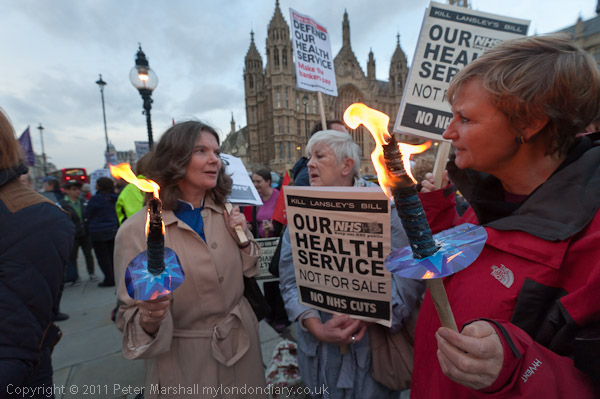
Our Health Service - Not for Sale - No NHS cuts
more pictures
Several hundred health workers gathered opposite the Houses of Parliament for a candlelit vigil as MPs gave the Health and Social Care Bill its third reading.
Pressure from Lib-Dem MPs led to a pause and some minor revisions in Andrew Lansley's Health and Social Care Bill in April, but these made little difference to the intention of the bill, which its opponents say is to break up and privatise the National Health Service.
The proposals have been rejected by most health professional and have led to numerous protests around the country, culminating in the massive TUC march in London on 26 March and a petition signed by over 400,000 people.
The bill is based on models from the USA, which many people find themselves unable to afford appropriate medical treatment. People who need expensive or long-term treatments are often told these are not covered by their insurance and can be faced with huge bills for drugs and medical care; costs of treatment there have soared as private firms operate them for profit.
Already in England the Department of Health is reported to be discussing handing the management of between 10 and 20 hospitals to a German firm, Helios. Various medical services, including intensive care beds and some whole areas of medicine are already being put out to tender in different areas of the country.
The plan to privatise the NHS began more than 20 years ago, with a significant landmark under New Labour in 2000, when then Health Secretary Alan Milburn reached an agreement with the so-called 'Independent Healthcare Association' which then represented most of the private hospitals and private health provision, about the direction in which healthcare here should be moving. Their joint vision was for the NHS simply to become an organisation that would provide a 'kitemark' to accredit health services provided by private companies. Lansley's bill if passed will make a great leap forward towards this, fragmenting the service, introducing commercialisation and market competition.
Campaigning group 'Keep Our NHS public' point out that in 2009 management consultants McKinsey drew up a list of treatments that might no longer be made available as a part of the NHS but which could be provided at a charge by private sector organisations - including hernias & varicose vein operations, knee & hip replacements and cataract operations.
It was inevitable that the government would get the bill through its third reading, although many were hoping that Lib Dem MPs would put up a rather greater fight. The fight against it will continue, with the hope that the House of Lords will fight to retain a comprehensive national health service, free at the point of need. For many years it was the envy of countries around the world, and although it clearly needs reform, it remains a service of which most of us are rightly proud and which we do not want to lose.
When the results of the vote were announced, there was a powerful feeling
of disappointment, disgust and anger. People are going to keep up the fight
for our National Health Service.
more pictures
Protest At Koch Bros Climate Change Deniers
Fenchurch St, London. Tuesday 7 September 2011
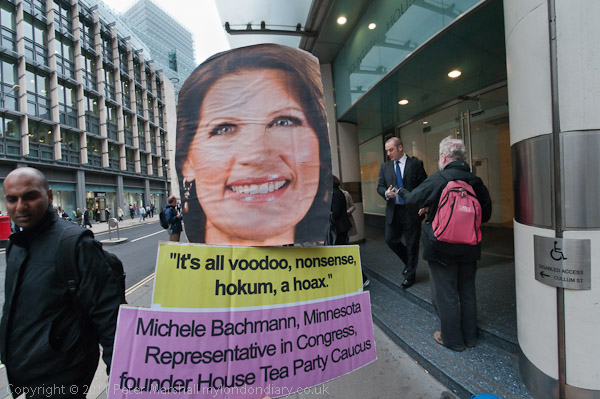
The US Tea party say climate change is all voodo, nonsense, hokum a hoax (Michelle
Bachmann)
more pictures
The Campaign against Climate Change protested outside the London offices of leading climate change deniers and Tea Party funders Koch Industries as workers came to and left the City.
Koch Industries is a huge privately owned US company that Koch Industries is a huge privately owned US company that operates oil refineries and other industries - one of its brands is Lycra. Owned by brothers Charles and David Koch, the company has a deplorable environmental record and has paid huge fines for various oil spills and other violations, although it expends massive amounts on political influence to evade penalties. According to the the Campaign against Climate Change (CCC):
"in April 2001 after Koch helped to elect George Bush in 2000, the Bush Justice Department abruptly settled a criminal case with $350 million in penalties that Koch faced for discharging toxic chemicals from a refinery in Corpus Cristi, Texas. "
Koch Industries has one of the largest teams of political lobbyists in the US, considerably larger than that of comparable companies and at times larger than that of the body representing the whole of the chemical industries.
Greenpeace in the US recently produced a damning report on their activities. As well as detailing many of their known safety and environmental violations it also exposes the large donations they have made to politicians on key safety committees in both chambers of Congress.
Koch industries are also major supporters of various right wing groups that deny that climate change exists or that it is a problem. Greenpeace in 2010 identified them as the leading funder behind climate change disinformation. David Koch himself was reported by Rolling Stone magazine claiming global warming as a benefit: "The Earth will be able to support enormously more people," he says, "because a far greater land area will be available to produce food."
Koch Industries have offices on one or two floors of Fountain House, a block
with a lengthy frontage of shops on Fenchurch Street with a smaller office
tower above. CCC came with a large banner and a balloon at 8 am to attract
attention and many of those entering the office building and hurrying elsewhere
along the street took copies of the leaflet which explained why they were
protesting against this company run by and supporting right wing extremist
climate change deniers and environmental criminals. On the back were portraits
of some of the public figures they support, including talk show host Glen
Beck (ex Fox News TV host), vice presidential candidate Sarah Palin,
Texas congressman and founder of 'Campaign for Liberty', Ron Paul,
Texas governor and Republican presidential candidate Rick Perry,
former congressman Dick Armey, chairman of 'FreedomWorks' and
representative Michelle Bachmann from Minnesota, the founder of the
House Tea Party Caucus.
In their evening protest which I photographed, CCC used placards with enlarged
portraits of these leading figures related to Koch Industries who are major
funders of the Tea Party movement. It was too windy for their very large banner,
and rather cold for the 'tea party' they had intended to stage, but they did
get out the cups (and teapot) for a picture.
The Tea Party movement not only denies the reality of climate change and
is preventing US moves to deal with it, but is also very much threatening
the global financial system by opposing President Obama's attempts to revive
the US Economy. The whole of the City of London should have been out there
protesting as well!
more pictures
Tower Hamlets Unites Against EDL
Aldgate and Whitechapel, London. Sat 3 Sept 2011
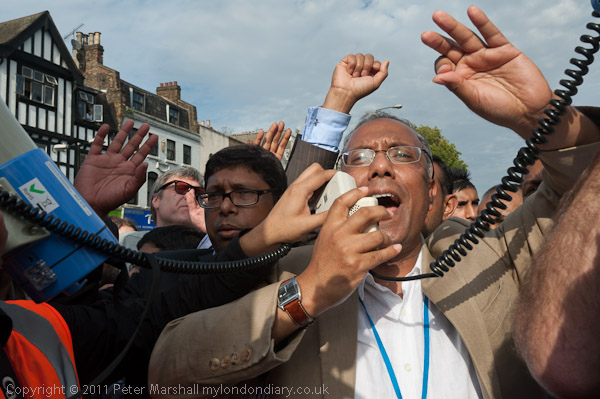
Lutfur Rahman, Mayor of Tower Hamlets congratulates the protesters and tells
them it is time to go home
more pictures
A peaceful protest by several thousand stopped the EDL from entering the Tower Hamlets and they celebrated with a short victory march. London, UK. 03/09/2011
The protest in Tower Hamlets by residents and their supporters against the plans by the English Defence League to hold a rally somewhere in their borough had started around 11am, but I only arrived at around the same time as the EDL had expected to be holding their rally.
I had heard that the static protest by the EDL was to be at the back of Aldgate East station. I made my way there but the street was empty with a row of police who refused to let me pass despite showing my press card. The EDL rally was held in front of Aldgate Station in the City of London - around a hundred metres short of their intended destination, Tower Hamlets.
Originally the EDL had intended to march through the area, but following the ban on marches announced by home secretary Theresa May after a request by the police had planned a static demonstration. This was planned to be on a supermarket car park close to the East London Mosque, but the supermarket refused to let them make use of the site, as did some other owners of possible sites.
The EDL was also denied access to various pubs across London where they intended to meet and march to the area, and the RMT union had stated they would close stations in London that the EDL wanted to use because of the danger this would cause to rail staff.
The EDL rally attracted fewer supporters than expected, and a a small number were turned back by police when trying to enter London. Others are said to have got lost after making considerable detours to find pubs that would serve them.
I returned to the junction of Commercial Street and Whitechapel High St, where a crowd of around a thousand had gathered to oppose the EDL. A little further down the road at the bottom of Brick Lane was another crowd of a similar size, and there were more people further along the Whitechapel Road close to the East London Mosque and still more at the corner of Vallance Road.
A great cheer went up from the crowd when it was announced over a megaphone that EDL leader Stephen Yaxley-Lennon (aka Tommy Robinson) had been arrested after speaking at the EDL rally, where he had apparently boasted of having broken his bail conditions.
There was jubilation too when the crowd heard that police were moving the EDL away from Aldgate and back to Liverpool Street Station and to the coaches waiting for them on Tooley St near London Bridge. The counter-demonstration had greatly outnumbered the EDL and had succeeded in stopping them reaching Tower Hamlets.
At around 4.20pm the protesters began a 'Victory March' from the bottom of Brick Lane along Whitechapel High St, led by the Mayor, councillors and others who linked arms across the width of the road.
Th march stopped outside the East London Mosque, but activists moved the front of the councillors and continued along the road. They were then briefly stopped by a line of police who told them that what they were doing was illegal as there was a ban on marches in the area, but the marchers were in no mood to stop. Some simply walked around the side of the police line, while others pushed their way through the heavily outnumbered police.
A few hundred yards on, stewards and some of the protest leaders managed
to bring the march to a halt, and several speakers urged the people to enjoy
their victory but not to continue with an illegal march which would result
in arrests and become the story of the day for the press rather than it being
one of a community victory over racism. Eventually the crowd calmed down;
some took up the offer of a cup of tea back in the Muslim Centre, while others
went home.
more pictures
Protest Against Repression In Syria
Downing St, London. Sat 3 Sept 2011
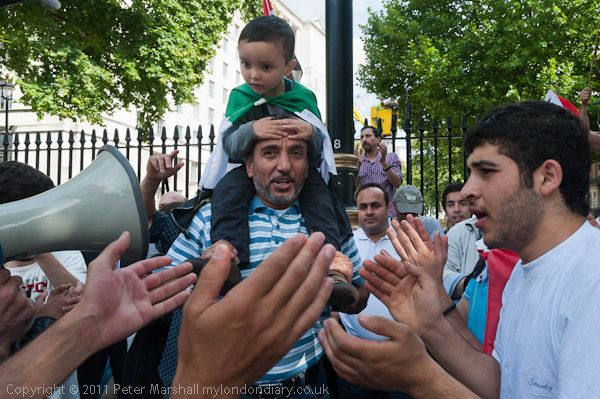
Syrians protest at killing of peaceful protesters in Syria
more pictures
Syrians of all ages marched from the Syrian embassy to a noisy protest at Downing St calling for freedom in Syria and an end to oppression, atrocities and humiliation by the Assad regime.
Around a hundred members of the Syrian Community in London protested at Downing Street, calling for further sanctions and diplomatic pressure to support the peaceful protests in Syria against the Assad regime and to bring freedom and democracy to their country.
Peaceful protests which began on the 15 March, calling for reforms have been met by brutal repression, with more than 1800 people killed, including many children. Soldiers who refused to open fire on civilians or take part in torture have been themselves killed.
Marches have been met with tanks, cities and villages attacked by helicopter gunships, men, women and children tortured, but the protests have intensified, now calling for the overthrow of the regime and the prosecution of President Assad as a war criminal.
The British Government has been among those calling for sanctions and condemnation of the Syrian regime and for reforms in the country. There were calls for further pressure on Russia to remove its veto on UN actions against the regime.
The solidarity protest included people of all ages, with several young children
taking an active part, and there was also a creche with other young children.
Many of the women taking part wore Muslim headscarves, but there were others
who did not, and although most of the drumming, dancing and flag-waving was
by the men, this was not a rigidly segregated event. Several flags were in
use, including both the current red, white and black Syrian tricolour with
its 2 green stars and the older green, white and black with three red stars
adopted by many taking part in the Syrian revolution. There were aslo some
red, black and green Libyan revoltionary flags and arm bands at the protest.
more pictures
Alternative Action Anti-Sharia Protest
St James to Whitehall, London. Sat 3 Sept 2011
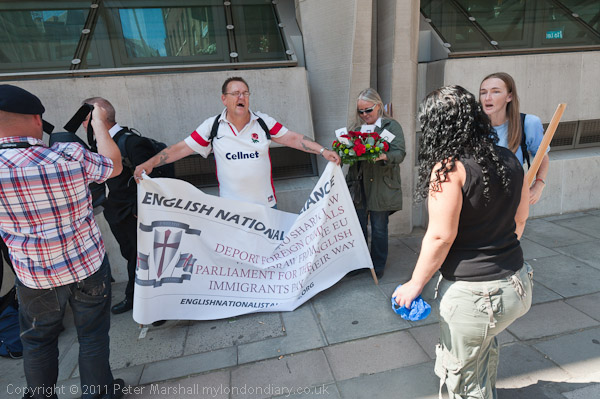
Time to march - getting ready opposite St James's Station
more pictures
Patriotic groups formerly allied to the EDL held an 'Alternative Action' march in London, and were disgusted when their letter to Downing St calling for one system of law in the UK and an end to Sharia courts was refused.
This small protest was in marked contrast to the events taking place in the City of London, where later police arrested around 60 of the EDL. Here the protesters made their protest in a quiet and generally dignified manner, apart from one small incident where English Nationalist Alliance leader Bill Baker got out his megaphone to shout at the Syrians demonstrating opposite Downing St against the repression of dissent in Syria, apparently under the misconception that they were Islamic extremists he told them to go back to Syria nad make their protests in their own country.
After a couple of minutes, one of the leaders of another of the groups involved in Alternative Action (AA) pulled him to one side and reminded him that they were not there to do that kind of thing, and the protest continued in its earlier more dignified manner.
AA brings together a number of "patriot activist groups" which have previously demonstrated with the EDL but now want to dissociate themselves from the loutish behaviour, violence and racism that has attended many EDL protests. They include the English Nationalist Alliance, the British Patriotic Alliance, the Combined Ex Forces, the Ex EDL Association and the National League of Infidels.
Their peaceful protest march and rally in Central London was organised to take place at the same time as the EDL were planning an imflammatory incursion into Tower Hamlets and was deliberately held well away from areas with a significant Muslim population. Previous events organised by groups including the ENA and March For England have been marred by the bad behaviour of EDL supporters, and EDL leader Tommy Robinson was reported as telling a meeting in Luton last week that the EDL would try to disrupt their peaceful march, but they did not turn up.
The setting up of AA also reflects various bitter disputes that have emerged on the web over the leadership and policies of the EDL, in particular over the lack of accountability in the organisation and the behaviour of some of its self-appointed leaders, including Robinson and the 'Jewish division' of the EDL.
The met at St James's Station and from their marched to lay wreaths at the Cenotaph. From there they went to Downing Street where they had arranged to hand in a letter before going on to hold a short rally in Waterloo Place.
The protest turned out to be considerably smaller than the organisers had expected, and I was told a few of those on their way to it were stopped and turned back by the police. Only around 20 people arrived, although well over a hundred had signed up for the event on Facebook. At 1.30pm they set off to march on the pavement to the Cenotaph, where one of the women present laid a wreath, watched closely by three former members of the Kings Regiment and a former Grenadier Guard from Combined Ex Forces, with the rest of the group observing in silence a few yards back. The ex-servicemen saluted, after which all of the group observed a minute's silence in memory of the soldiers who have given their life for their country.
The march then moved on to Downing St, where they attempted to deliver a letter, following arrangements that had been made earlier in the week with the Downing St police liaison officer, but police there refused to take it.
James Devine, second in command of the Combined Ex Forces, made a lengthy statement in which he expressed the disgust of the protesters. By refusing to take the letter today, the Prime Minister has shown he has no respect for servicemen". It showed "a total disrespect for the armed forces." He went on to say that the government "work for the British people" and should be ready to listen to them, and that "they are traitors."
The letter, which should be available on the web shortly, demanded that the British government takes action to ensure that everyone in Britain came under the same law, and that there should be no Sharia courts (or other religious courts) in this country. Before the election, David Cameron had expressed his agreement with this but in power had done nothing about it. This is the latest in a series of similar letters delivered by previous marches, and the civil servants who had replied to these had failed to answer any of the points in them.
Opposite Downing Street there were a group of Syrians protesting against the continuing repression of protests in their country. The AA protesters lined up beside their banner facing them across the road. At least some of those taking part felt that it was inappropriate to allow protests involving foreign flags so close to the Cenotaph with its flags honouring our military dead, although the Syrians (and many others who regularly protest in the area opposite Downing St) do so because it is the closest the police allow protests to Downing St, and certainly intended no disrespect to the British armed forces.
I left the AA protest at this point, as, after the incident mentioned above,
it continued to protest peacefully on the pavement just part Downing St for
some minutes before continuing on its way to Waterloo Place. From there some
at least of those present were intending to go on pay their respects at the
grave of the Unknown Warrior in Westminster Abbey.
more pictures
Brian Haw Peace Protest Continues
Parliament Square, London. Sat 3 September 2011
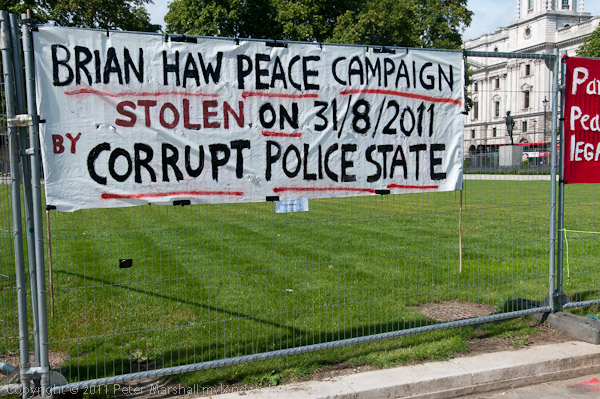
The campaign in Parliament Square still continues 24/7
more pictures
The permanent 24/7 peace protest in Parliament Square begun by the late Brian Haw more than ten years ago is continuing despite the campaign by police and politicians to bring it to an end. On 31 August, police came and removed the display despite the protests of the campaign members present at the site, saying that it had been abandoned despite their protestations. This was not the first time that the display here has been stolen by police, the most famous being in May 2006, after which a reconstruction by an artist was controversially put on display at Tate Britain.
Since then, the size of the display has been restricted, but the protest has remained continuous despite harassment and arrests of Brian Haw, Barbara Tucker and others involved. Since Brian's death Barbara has been the main campaigner at the site but is helped by a team of others, who have kept up the protest since she was sent to Holloway Prison for a few weeks.
As well as the Brian Haw campaign there are other campaigners present in
the square most of the time, including the Peace Strike campaign and various
other groups. It seems to me a scandal that Parliament Square is still kept
fenced off by the council and the public are denied access to the statues
of Churchill, Lloyd George and others.
more pictures
All pictures on this section of the site are Copyright © Peter Marshall 2011; to buy prints or for permission to reproduce pictures or to comment on this site, or for any other questions, contact me.

